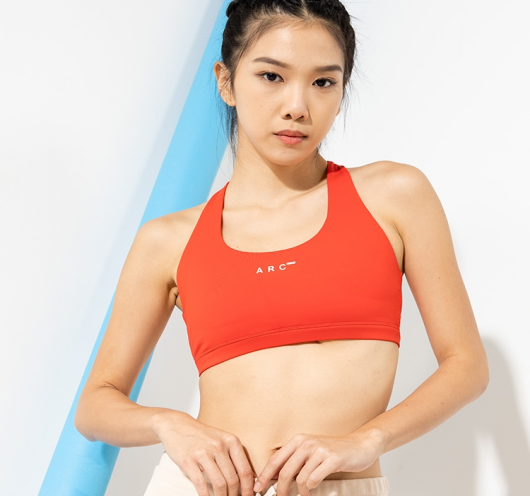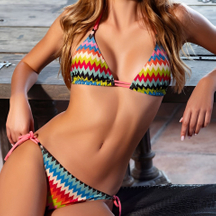Yoga clothes are clothes worn for practicing yoga. Generally speaking, yoga suits are divided into long sleeved, medium long sleeved, short sleeved, vest, and suspender, while pants are mostly straight, flared, and lantern pants.Yoga clothing belongs to the category of wearing close fitting clothing, and yoga exercises can leave a lot of sweat during exercise, so the material of yoga clothing is crucial. There are many common fabrics for yoga suits, mainly the following!

1. Quick Drying
Quick drying fabric is a common fabric for sportswear, belonging to a double-layer structure fabric. The close layer is non absorbent but porous synthetic fiber, and the outer layer is a absorbent cotton blend. Generally, there are more synthetic and polyester fibers, which will not stick to the clothes after sweating, making them more comfortable.Advantages: Strong volatility and water absorption, good moisture dissipation and warmth retention, keeping the skin dry and refreshing, and can play a better role in wind, rain, and moisture prevention.
Disadvantages: If the quick drying fabric contains 100% polyester fiber, it is not a comfortable state for the human body to wear.
2. Odell
Odell fabric is a high-end fiber made by weaving plant protein fibers through a special process, and then weaving cotton and this plant protein fiber to form a fabric. It belongs to an environmentally friendly textile fabric.
Advantages: Good moisture absorption and conductivity, large elasticity, soft and breathable, with hanging and flowing performance, light and thin texture, smooth, not easy to shrink, easy to wash, and quick to dry.
Disadvantages: This fabric belongs to natural fiber fabric, which is expensive and easy to buy counterfeit goods.
3. Modal
Modal fiber is a type of cellulose fiber, which, like artificial cotton, belongs to the category of cellulose fiber and is a pure artificial fiber. It is made from wood pulp produced from shrublands in Europe and processed through a specialized spinning process. It is now mostly used in the production of underwear.
Advantages: Soft feel, strong moisture absorption, bright color, good drape, and natural wrinkle resistance and heat resistance of the fabric.
Disadvantages: The fabric has poor firmness, is prone to fuzzing, and is relatively expensive.
4. Cations
Cationic fabrics are all polyester fabrics, usually using cationic silk in the warp direction and ordinary polyester silk in the weft direction. Sometimes, in order to achieve better linen like effects, two components of polyester and cationic fibers are mixed and spun.
Advantages: Soft feel and comfortable to wear. The water absorption is very good, and its dyeing cylinder difference is relatively small, so it is particularly suitable for sports clothes.
Disadvantages: Cationic fabrics have almost no drawbacks, but the production cost is relatively high compared to polyester fabrics, making them easy to be replaced by colored woven fabrics.
5. Leica
Lycra fabric is a fabric made of spandex fiber (abbreviated as Spandex polyurethane fiber), also known as "pull frame" in Cantonese (Lycra's Cantonese pronunciation), and sometimes directly referred to as "spandex fabric" in mainland China.
Advantages: It has good elasticity and is not easily deformed. Adding Lycra to the fabric can enhance its elasticity. Lycra can be combined with various fibers without changing the appearance and texture of the fabric. The fabric is very soft.
Disadvantage: Lycra fabric must be blended with other fibers, otherwise it will not produce finished fabrics.
6. Bamboo Fiber
The term "bamboo fibre fabric" refers to a newly developed category of fabric that is woven from bamboo fibres after being created from bamboo as a raw material using specialised textile manufacturing techniques. It is a completely natural and green fibre that is also kind to the environment.
Advantages include being soft and warm, absorbing moisture and being breathable, having antibacterial and antibacterial properties, being resistant to UV rays, being warm in the winter and cool in the summer, having the natural beauty effect of bamboo, having naturally occurring anti mite, anti odour, and anti insect negative ion characteristics, as well as having natural health, being green, and protecting the environment.
Disadvantages: Short service life, after usage for some time, the cotton loop is easy to fall off, losing its earlier smoothness, softness and warmth, becoming dry and hard; the breathability and quick water absorption gradually diminish after use.
7. Viscous Fiber
A fabric that is woven from viscose fibres is called viscose fibre fabric, and it possesses qualities such as being soft, silky, breathable, anti-static, and colourful when it is dyed.
Feeling that is soft, silky, breathable, and cool are all advantages. It has a very powerful anti-static function, but it does not give the impression that it is attached to the body, which makes it very smooth and particularly suited for use in athletic wear.Viscose fibres have a heavy hand feel, poor elasticity, are prone to wrinkles, and do not straighten out easily. Additionally, viscose fibres are easily deformed.

8. Milk Shreds
Milk silk is produced by first making milk slurry, which is then spun into milk protein fibres using wet spinning technology and scientific processing, and then spinning the milk protein fibres into milk silk, which can then be woven. Milk silk is produced by the process of adding a softener to milk protein in order to create milk slurry.
Advantages include good heat retention, a high moisture-conductivity, colouring, skin friendliness, a refreshing feel, wear resistance, anti-pilling properties, and a reduced susceptibility to mould growth.Milk thread has a little reduced capacity to absorb perspiration and breathe compared to other types of thread, which is a disadvantage.
9. Nylon
The name nylon refers to a group of polyamide fibres that are manufactured in China and are collectively referred to as nylon. Because of its great wear resistance, durability, and moisture absorption, nylon fabric is a lightweight fabric. Nylon fabric also offers excellent resistance to wear.
Advantages: Excellent elasticity and elastic recovery, with wear resistance ranking first among various fabrics and many times higher than other fibre textiles of similar items. This fabric's wear resistance also ranks first among various fabrics. Due to this fact, its durability is exceptional.
Negatives aspects include the following: During use and wear, the cloth has a low resistance to heat and light, and it has a tendency to wrinkle and distort when subjected to even moderately sized external forces. In order to prevent the fabric from becoming damaged while being worn and used, it is essential to pay close attention to the washing and maintenance conditions that are present.
The practise of yoga is an exercise in self-development that places an emphasis on uniting the human race with the natural world. As a result, it is not a good idea to wear yoga gear in a casual setting. When you stretch clothing made of inferior fabric, it is more likely to develop holes, wrinkles, or discoloration. Therefore, students of yoga need to be mindful of the materials they wear as they practise the discipline.
The name nylon refers to a group of polyamide fibres that are manufactured in China and are collectively referred to as nylon. Because of its great wear resistance, durability, and moisture absorption, nylon fabric is a lightweight fabric. Nylon fabric also offers excellent resistance to wear.
Advantages: Excellent elasticity and elastic recovery, with wear resistance ranking first among various fabrics and many times higher than other fibre textiles of similar items. This fabric's wear resistance also ranks first among various fabrics. Due to this fact, its durability is exceptional.
Negatives aspects include the following: During use and wear, the cloth has a low resistance to heat and light, and it has a tendency to wrinkle and distort when subjected to even moderately sized external forces. In order to prevent the fabric from becoming damaged while being worn and used, it is essential to pay close attention to the washing and maintenance conditions that are present.
The practise of yoga is an exercise in self-development that places an emphasis on uniting the human race with the natural world. As a result, it is not a good idea to wear yoga gear in a casual setting. When you stretch clothing made of inferior fabric, it is more likely to develop holes, wrinkles, or discoloration. Therefore, students of yoga need to be mindful of the materials they wear as they practise the discipline.

































































